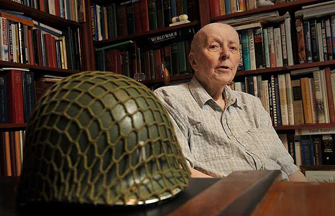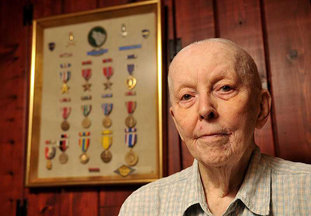“Devotion to Duty”
March 2017 | Written by Kelsey O’Halloran | Lake Oswego Review
Lake Oswego veteran Art Sorenson recalls his decorated service in the U.S. Army during World War II.

REVIEW PHOTO: VERN UYETAKE – With his Army helmet close by, Lake Oswego veteran Art Sorenson tells stories from his military service in World War II.
In a modest frame in Art Sorenson’s Lake Oswego home office hang nearly two dozen military patches, badges and medals. Each one tells a story of his time in Europe, where he served with the U.S. Army from 1942 to 1945. The medals — which include high honors such as a Silver Star, two Bronze Stars and a Purple Heart — highlight what many would consider heroic achievements. Sorenson simply sums up the honors as part of “an interesting life.”
Sorenson grew up in Toppenish, Wash., a small town on the Yakama Indian Reservation. He graduated from Toppenish High School in 1940 and later enrolled at the University of Washington, eventually settling on a pharmacy major. While in college, he joined the Army Specialized Training Program (ASTP). Through the program, university students who joined the Army could remain in school and receive Army pay until they graduated. But Sorenson was about a year and a half into college when the Army needed more troops and began reducing the ASTP program, transferring Sorenson and thousands of other young men to the infantry.
Carrying a Comrade
Sorenson completed his basic training in Fort Benning, Ga., and was then sent to the 104th Infantry Division, also known as the Timberwolf Division. He landed on Omaha Beach in 1944. After one of his first major battles — the Battle of Hill 287 — Sorenson and his fellow troops were planning their next move in the basement of an apartment complex in the industrial city of Weisweiler when the Germans attacked, throwing hand grenades down onto them. “Before we knew it, we were standing behind the building as prisoners,” he says. One of the American soldiers, Jim Lee, was badly wounded, Sorenson recalls. So as they marched with German guards, “my buddy and I carried him” for about 20 miles, he says. When they reached a German hospital, the staff was busy with their own wounded, Sorenson says, so he helped himself to their supplies. “I cleaned his wounds and put bandages on and did the best I could,” he says, before the group continued on toward a German prisoner of war camp. Sorenson and his buddy were still walking with Lee when they ran into an artillery barrage, he says. In the chaos, the three men ducked into the basement of a bombed-out house and hid for several days, until they were found by Americans and reunited with their unit.
Earning His Star

REVIEW PHOTO: VERN UYETAKE – World War II veteran Art Sorenson of Lake Oswego has earned many honors, including a Silver Star, two Bronze Stars and a Purple Heart.
Sorenson earned his Silver Star — one of the Army’s highest honors — in November 1944. He and his unit were back in Weisweiler and conducting a night assault when they were cut off by a counterattack. Knowing that the stranded unit was in need of supplies and ammunition, Sorenson organized and led a patrol through enemy lines and across a river to the company supply depot. When they returned to the river, they found that the footbridge they’d used before had been blown up — so Sorenson “ventured out alone over 300 yards of fire-swept terrain” to find a place where his troops could wade across the river, according to the medal citation. “His devotion to duty, unselfish loyalty to his comrades and utter disregard for personal safety in the face of deadly enemy fire exemplify the finest traditions of the American combat soldier and reflect distinct credit upon himself and the armed forces of the United States,” the citation reads.
During the Battle of the Bulge, Sorenson’s division held their ground, going 196 days on the front lines without relief. He and his fellow troops couldn’t wear overcoats for fear of attracting friendly fire — long overcoats were part of the German uniform — so he says they were always cold. Shortly after the Battle of the Bulge, he and his company came across the Nordhausen concentration camp, where Nazi scientists and soldiers were starving Jewish prisoners until they died. “We buried 6,000 people the first day,” he says. “We sent our medics in to determine who was alive or dead. That was really tough.” Sorenson says his unit was the first to capture a concentration camp.
Life After the War
After the war in Germany ended, Sorenson and his unit sailed from France in July 1945 to spend a month at Camp San Luis Obispo in California. The unit was slated to go to Tokyo next — as an assault division — until the U.S. dropped nuclear bombs on Hiroshima and Nagasaki. Sorenson estimates that the assault on Tokyo would have resulted in millions of American casualties, so he believes now that the nuclear attacks saved his life. “I wouldn’t be here today if it hadn’t been for those bombs,” he says.
Sorenson remained at the camp in California until December 1945 and then resumed his classes at the University of Washington in January 1946, graduating with a pharmacy degree in 1948 and launching into a 40-year career at the pharmaceutical company Parke-Davis. In 1990, he met his wife, Betty, at a Seattle reunion for his Army outfit, the National Timberwolf Association. Looking back on his career and retirement, Sorenson says he’s had a good life. Even the war — the constant cold, the injuries and losses and the suffering he witnessed at Nordhausen — is something that not many people had the chance to experience, he says. “It was a part of history that I wouldn’t want to do again,” he says. “But I’m glad I did it once.”
